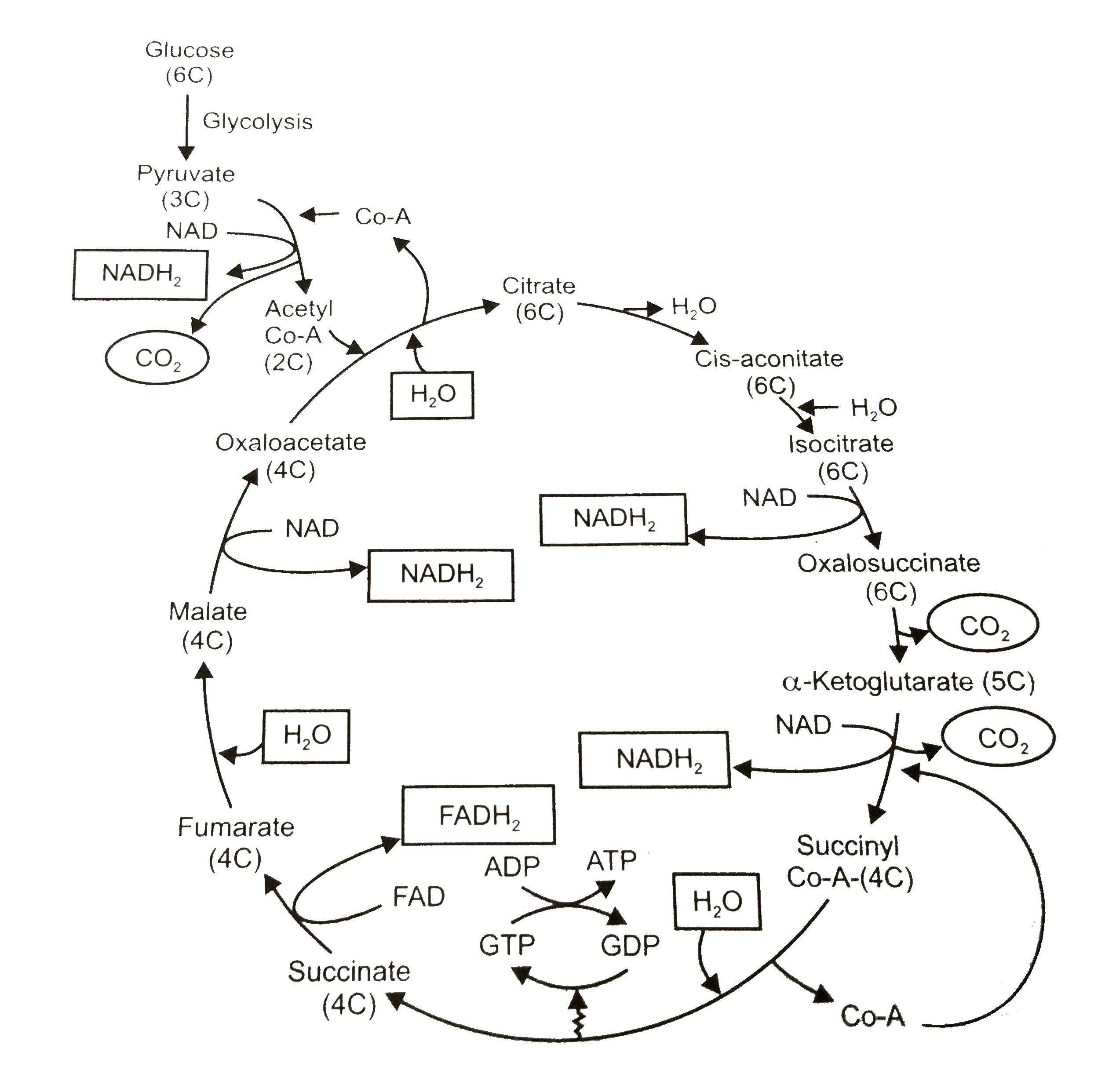Give the schematic representation of an overall view of Krebs cycle.
Video Solution
Text Solution
Acetyl Co - A formed from pyruvate durinf the process of respiration undergoes complete oxidation through a series of reaction which was discovered by Sir Hans Kreb's. Citric acid is the first stable compound having three carbonyl groups . Hence , Kreb's cycle is also known as tri - carboxylic acid cycle or citric acid cycle .
Formation of citric acid : Acetyl Co-A which is formed from pyruvate reacts with oxalacetate (4 C) to form citrate . One H2O molecule is utilized in the reaction . Enzyme citrate synthetase catalyses this reaction . Co - A produced during this reaction is recycled, for the conversation of pyruvate to acetyl Co - A.
Isomerisation of citrate to isocitrate (Dehydration and hydration ) : Citrate undergoes isomerisation to form isocitrate.
The steps are :
1 . First of all citrate undergoes dehydration by loosing one molecule of H2O and forms cis-aconitate under enzyme acotinase .
2. Cis - aconitate undergoes hydration to form isocitrate by taking back one molecule of H2O.
Cis−aconitate+H2OAcotinase−−−−−→ Isocitrate.
Oxidaton of Isocitrate : After oxidation isocitrate forms oxalo - succinate . In this reaction H removed is accepted by coenzyme NAD which form NADH2 after accepting H , in presence of isocitrate dehydrogenase with Mn2+ as co- factor .
Isocitric acid + NAD Isocitrate dehydrogenase−−−−−−−−−−−−−−→Oxalosuccinate + NADH_(2)
Decarboxylation : Oxalosuccinate undergoes decarboxylation in the presence of decarboxylase to form ∝− ketoglutarate . A molecule of CO2 is relased .
OxalosuccinateDecarboxylase−−−−−−−→∝−ketoglutarate+CO2
Oxidative decarboxylation : ∝ - ketoglutarate under- goes oxidative decarboxylation to form succinyl Co- A , in presence of ∝ - ketolutarate dyhydrogenase .
∝−ketoglutarate+NAD+Co−A→SuccinylCo−A+NADH2+CO2
Hydration and phosphorylation of succinyl Co-A:
It undergoes hydrolysis to form succinate with release of Co-A , in the presence of succinyl thiokinase. Energy released is utilised by GDP to from GTP (Guanosine triphosphate ) and iP. GTP formed reacts with ADP to form ATP . This type of ATP formation is called substrate level phosphorylation .
Oxidation of succinate : Succinate oxidises to form fumarate . H2 removed is accepted by FAD to form FADH2. Enzyme succinate dehydrogenase is present and Fe2+ as a co - factor .
Succinate + FAD Succinate dehydrogenase −−−−−−−−−−−−−−−→Fe2+Fumarate+FADH2
Hydration of fumarate : After hydration fumarate combines with H2O to form malate in the presence of fumarase .
Fumarate+H2OFumarase−−−−−→Malate.<br>OξdationofMalate:Malateundergoes⊗tion→form⊗aloacηte.Hremoveddur∈gthisreactionisaeptedbyNAD→omNADH_(2).<br>Oxaloacetate is thus regenerated to combine with acetyl Co - A to keep the cycle going .
Malate + NAD Malate dehydrogenase−−−−−−−−−−−−→Oxaloacetate + NADH_(2)

|
Updated on:21/07/2023
Topper's Solved these Questions
- BOOK - GURUKUL PUBLICATION - MAHARASHTRA PREVIOUS YEAR PAPERSCHAPTER - MARCH 2015EXERCISE - section II23videos
MARCH 2015
- BOOK - GURUKUL PUBLICATION - MAHARASHTRA PREVIOUS YEAR PAPERSCHAPTER - MARCH 2014EXERCISE - SECTION - II (ZOOLOGY)26videos
MARCH 2014
- BOOK - GURUKUL PUBLICATION - MAHARASHTRA PREVIOUS YEAR PAPERSCHAPTER - MARCH 2016EXERCISE - SECTION-II24videos
MARCH 2016
Similar Questions
Knowledge Check
- Question 1 - Select One
Kreb's cycle
ALiberates a minor part of energy during respirationBIs operative in photorespirationCReactions are independent of oxygen supplyDIs a link between carbohydrate and nitrogen metabolism - Question 2 - Select One
Krebs cycle is
AOxidation of glucose to alcohol and waterBOxidation of acetyl CoA to carbon dioxide and water involving electron transportCComplete oxidation of acetyl CoA without electron transportDComplete reduction of acetyl CoA to carbon doxide and water. - Question 3 - Select One
Krebs cycle is
AAerobicBAnaerobicCAnabolicDNone of the above

